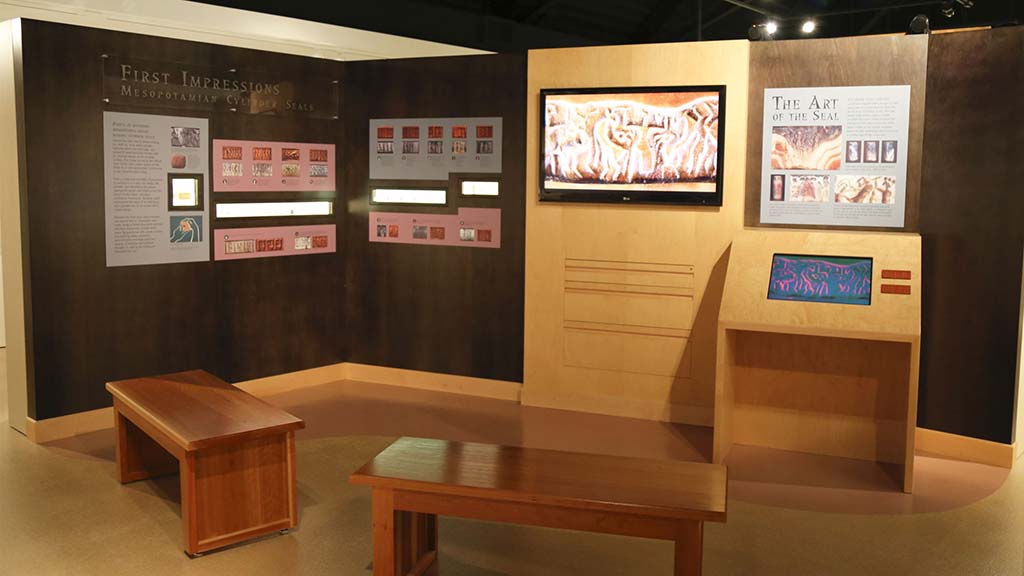
Mesopotamian Cylinder Seals Collection
The Spurlock Museum houses a collection of 59 ancient Mesopotamian cylinder seals. These are small stone cylinders, about an inch tall, with carved designs on their curved surfaces. The seals were rolled along the wet clay of a cuneiform tablet, creating an impression of the design on the surface that acted as the owner's identifying mark, somewhat like the modern signature. The Museum's collection includes seals from as early as 3200 BCE and as late as 450 BCE.
-
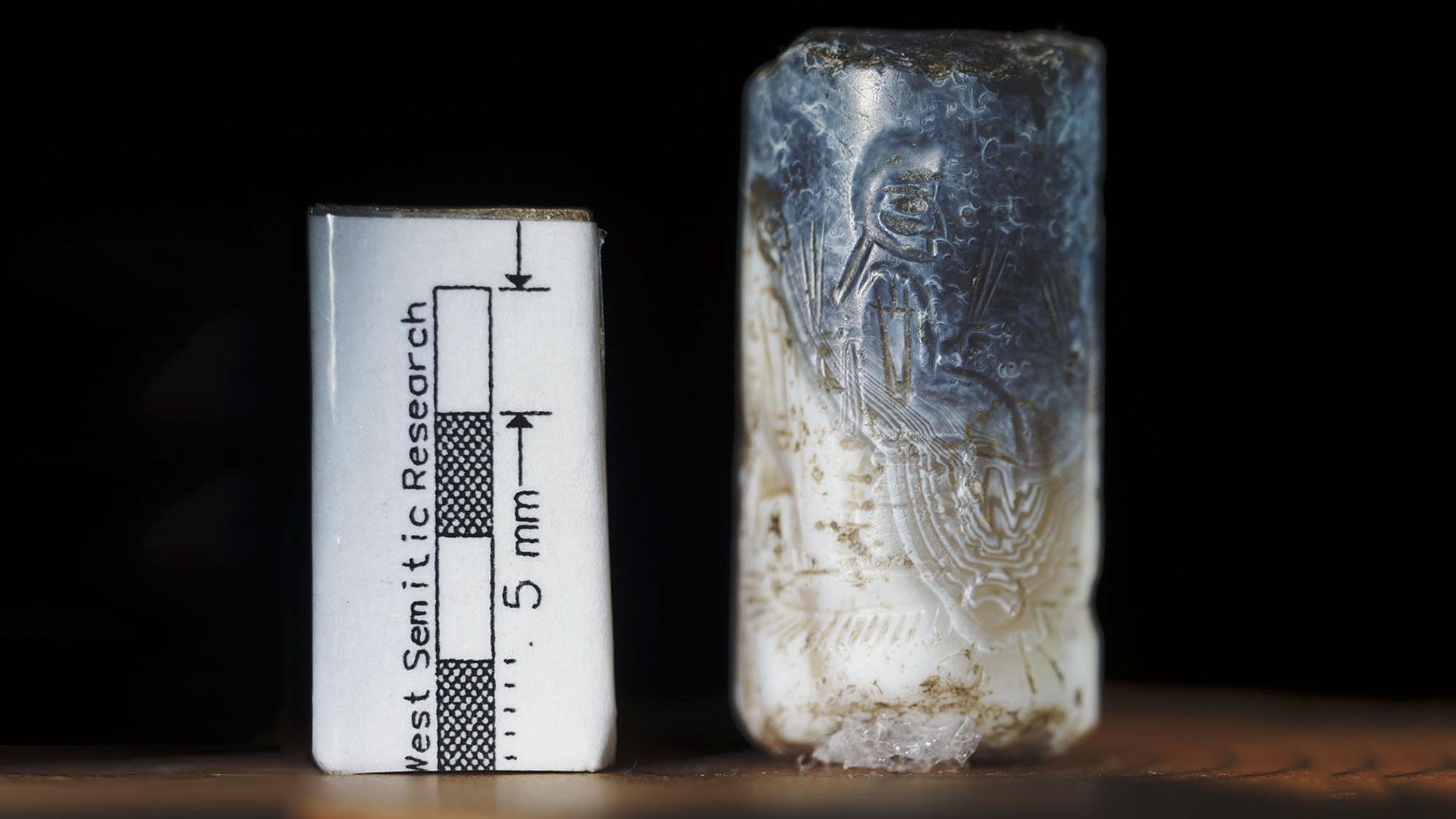 This conventional photograph illustrates what the following seals actually look like. Persian Period (ca. 520–400 BCE) agate with alternating bands of white and brown, below a section of gray 1900.53.0052A
This conventional photograph illustrates what the following seals actually look like. Persian Period (ca. 520–400 BCE) agate with alternating bands of white and brown, below a section of gray 1900.53.0052A
Imaging the Seals
Our Artifact Imaging Center has a camera that takes flat images of cylindrical surfaces, providing unique, high-resolution photographs of the entire carved designs on the seals. This gallery provides some examples of the 360-degree images so you can get a better sense of the artists' work.
The 15 images below represent a sampling of the 59 objects in the collection. These images were taken using the special process that has enlarged the seals and has "flattened" their cylindrical surface. Traditional photos and other details can be viewed by clicking the number under each image.
-
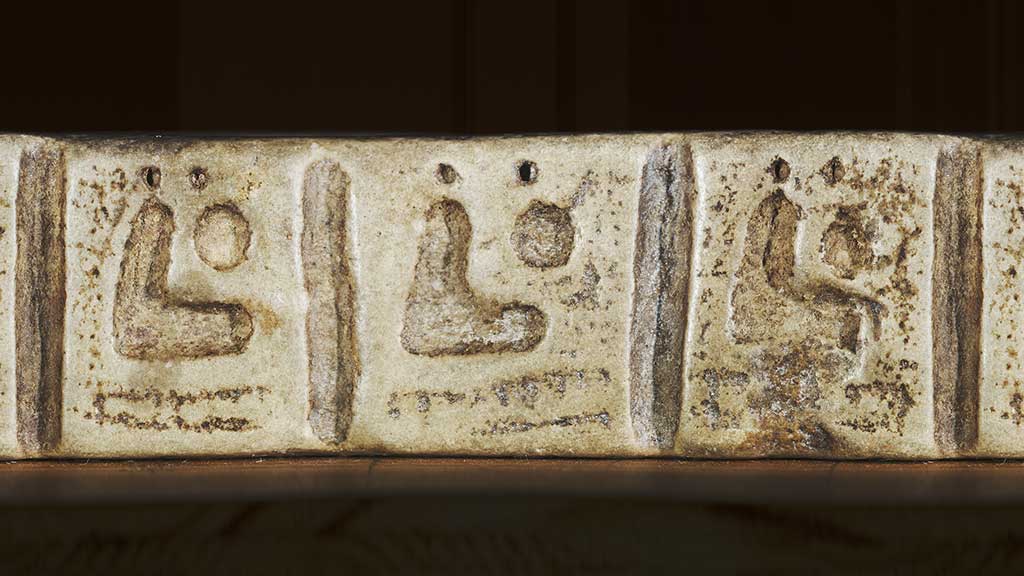 Abstract scene of female potter sitting on mat. limestone Jemdet Nasr Period (ca. 3200–3000 BCE) 1900.53.0117A
Abstract scene of female potter sitting on mat. limestone Jemdet Nasr Period (ca. 3200–3000 BCE) 1900.53.0117A -
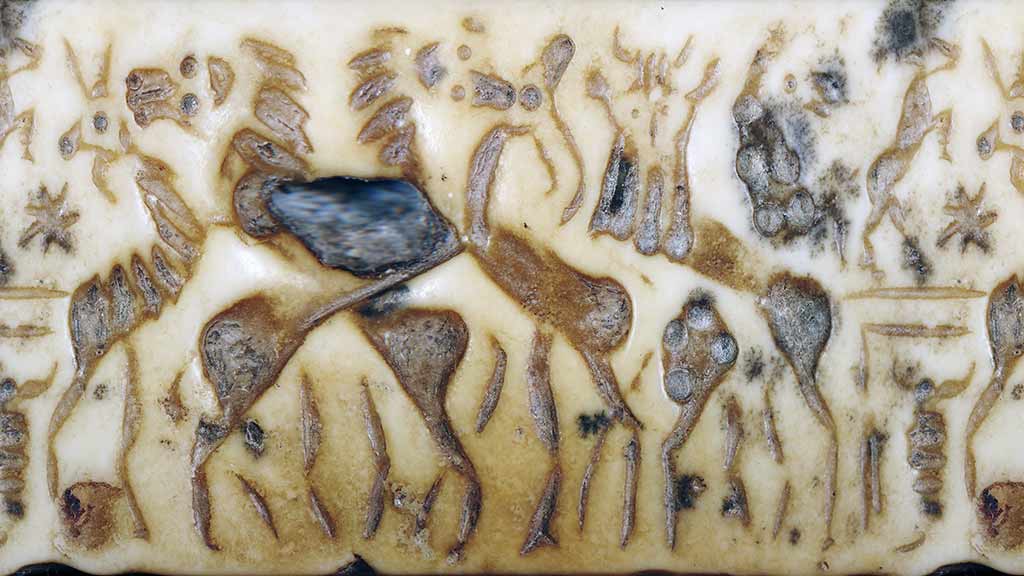 From left: two lions jump across one another to attack their prey, a goat on the left, a gazelle on the right. To the right are two other animals jumping across each other (the left of this pair directly faces the viewer). The final element is a small calf on its hind legs over a scorpion. marble Early Dynastic III Period (ca. 2600–2350 BCE) 1900.53.0108A
From left: two lions jump across one another to attack their prey, a goat on the left, a gazelle on the right. To the right are two other animals jumping across each other (the left of this pair directly faces the viewer). The final element is a small calf on its hind legs over a scorpion. marble Early Dynastic III Period (ca. 2600–2350 BCE) 1900.53.0108A -
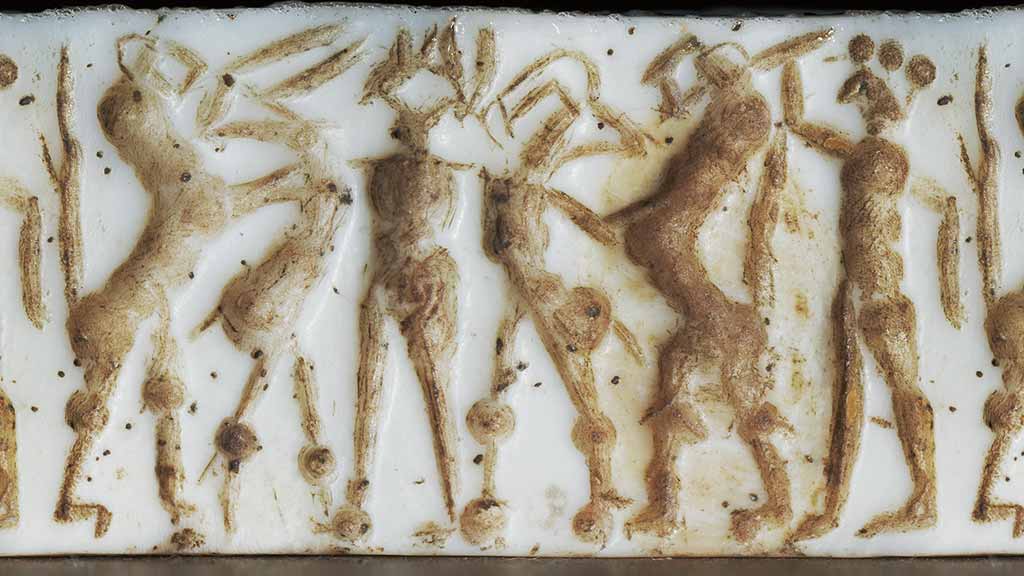 Two lions each attack a gazelle. A hero grabs the gazelles away from the lions, while another hero on the right stabs one lion with his knife. seashell Early Dynastic III Period (ca. 2600–2350 BCE) 1900.53.0106A
Two lions each attack a gazelle. A hero grabs the gazelles away from the lions, while another hero on the right stabs one lion with his knife. seashell Early Dynastic III Period (ca. 2600–2350 BCE) 1900.53.0106A -
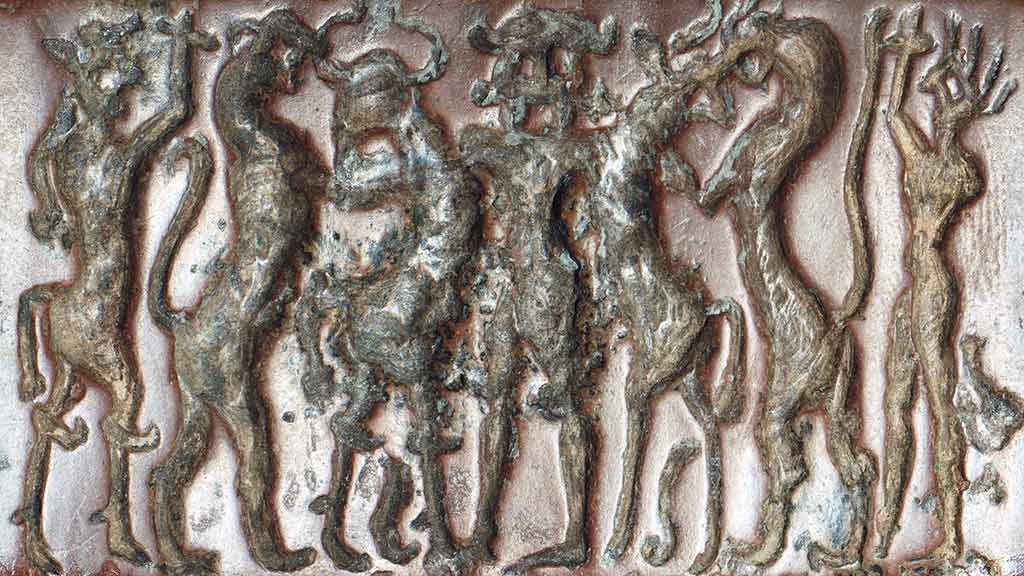 In the center a hero pulls a bull and a cow away from two attacking lions, while on the left a bull-man stabs one of the lions, and on the right a hero stabs the other. red steatite Early Dynastic III Period (ca. 2600–2350 BCE) 1900.53.0104A
In the center a hero pulls a bull and a cow away from two attacking lions, while on the left a bull-man stabs one of the lions, and on the right a hero stabs the other. red steatite Early Dynastic III Period (ca. 2600–2350 BCE) 1900.53.0104A -
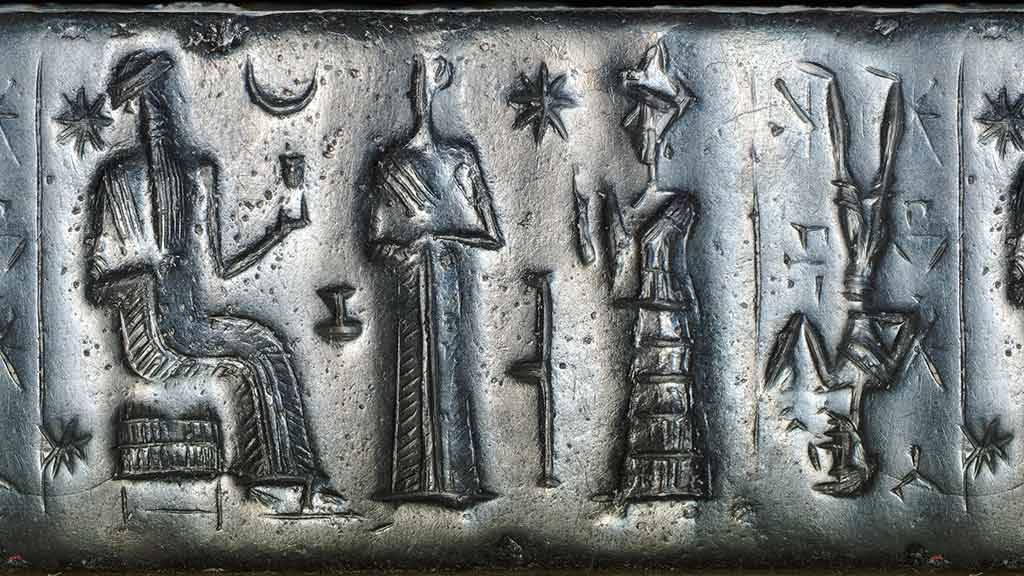 A long-bearded divine king sits on a padded throne. Before him stands a worshiper. Behind the latter stands the presenting goddess Lama. The upside-down figure was carved over the name of the original owner to change the design for the seal's new owner. hematite with jasper patches Isin-Larsa Period (ca. 1900–1800 BCE) 1900.53.0061A
A long-bearded divine king sits on a padded throne. Before him stands a worshiper. Behind the latter stands the presenting goddess Lama. The upside-down figure was carved over the name of the original owner to change the design for the seal's new owner. hematite with jasper patches Isin-Larsa Period (ca. 1900–1800 BCE) 1900.53.0061A -
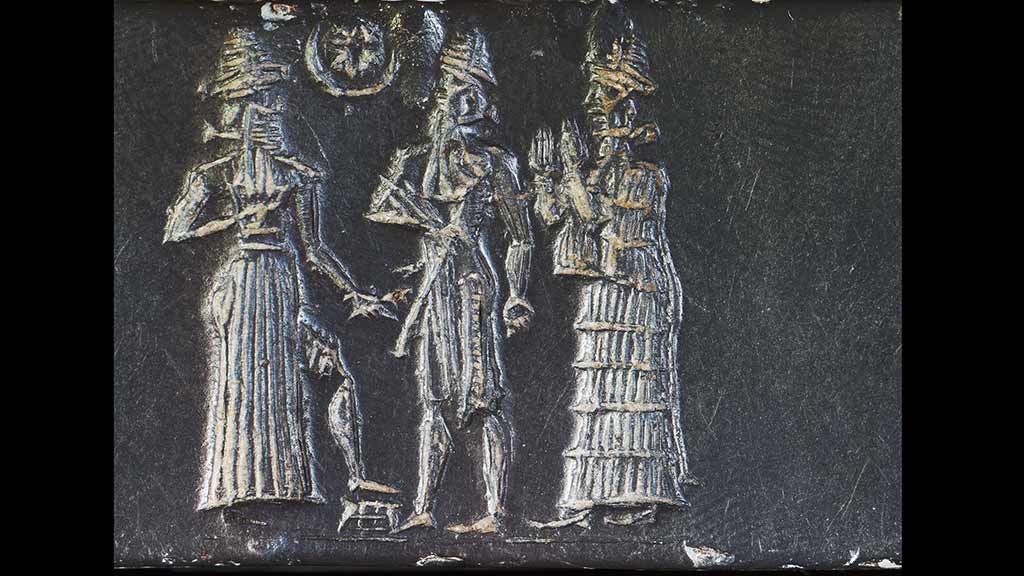 On the left, the sun-god Shamash stands with his foot on a stool that represents a mountain. Before him is the king in his military uniform seeking the god’s blessing. Behind the king is the presenting goddess Lama. hematite Old Babylonian Period (ca. 1800–1600 BCE) 1900.53.0067A
On the left, the sun-god Shamash stands with his foot on a stool that represents a mountain. Before him is the king in his military uniform seeking the god’s blessing. Behind the king is the presenting goddess Lama. hematite Old Babylonian Period (ca. 1800–1600 BCE) 1900.53.0067A -
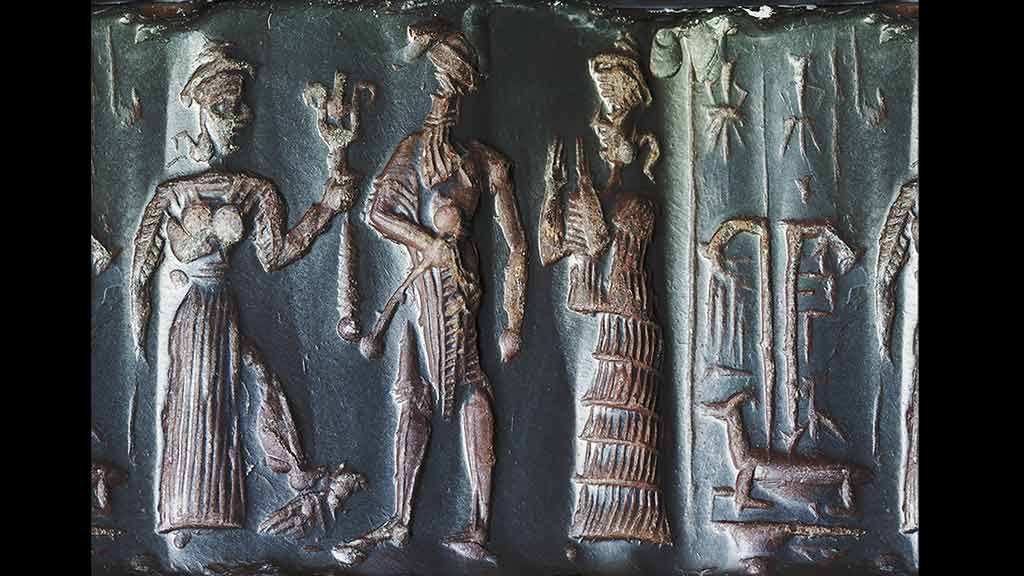 Here the king in his military outfit stands before Ishtar, the goddess of love and war, with Lama behind him. hematite Old Babylonian Period (ca. 1800–1700 BCE) 1900.53.0069A
Here the king in his military outfit stands before Ishtar, the goddess of love and war, with Lama behind him. hematite Old Babylonian Period (ca. 1800–1700 BCE) 1900.53.0069A -
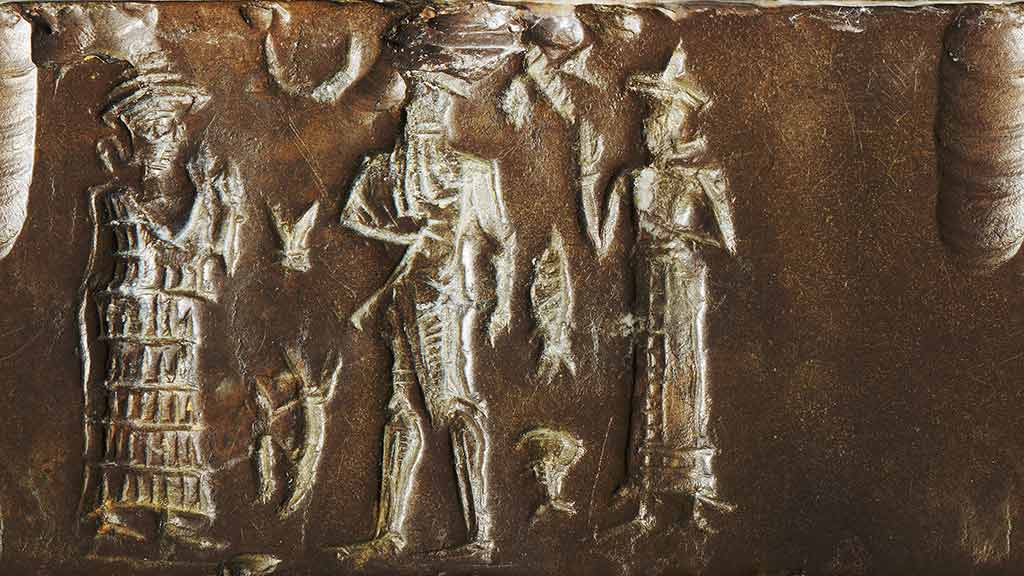 The king stands before Lama, who appears in her standard pose. Behind the king is a god whose identity is not known. limonite Old Babylonian Period (ca. 1800–1600 BCE) 1900.53.0071A
The king stands before Lama, who appears in her standard pose. Behind the king is a god whose identity is not known. limonite Old Babylonian Period (ca. 1800–1600 BCE) 1900.53.0071A -
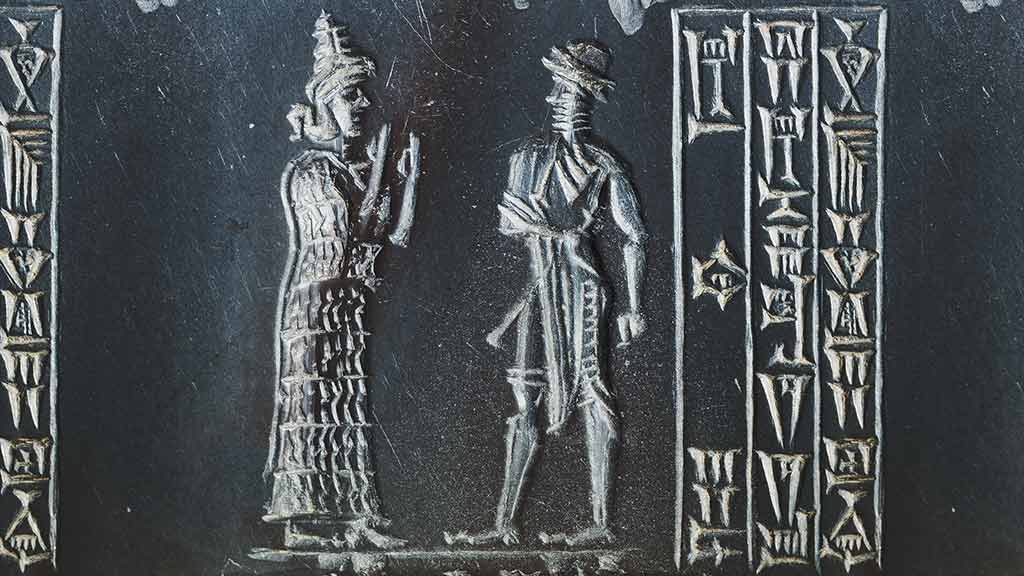 Seal of Dakia, son of Damiq-ilishu, servant of King Samsu-iluna of Babylon. Here only the king and Lama are present, facing each other. hematite Old Babylonian Period (ca. 1750–1712 BCE) 1900.53.0077A
Seal of Dakia, son of Damiq-ilishu, servant of King Samsu-iluna of Babylon. Here only the king and Lama are present, facing each other. hematite Old Babylonian Period (ca. 1750–1712 BCE) 1900.53.0077A -
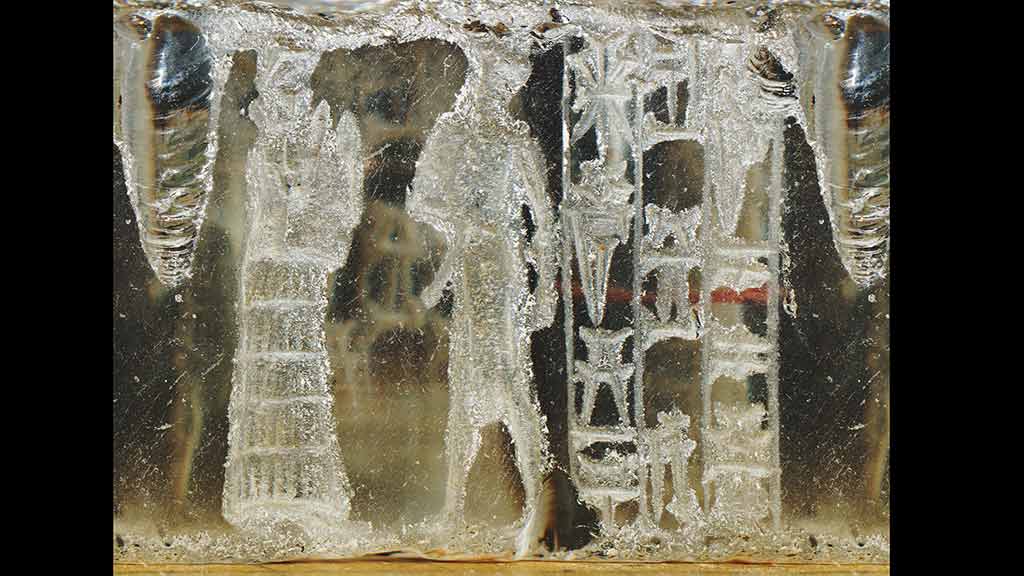 This nearly transparent seal shows the popular motif of the previous seal—the king standing before Lama. rock crystal Old Babylonian Period (ca. 1800–1600 BCE) 1900.53.0073A
This nearly transparent seal shows the popular motif of the previous seal—the king standing before Lama. rock crystal Old Babylonian Period (ca. 1800–1600 BCE) 1900.53.0073A -
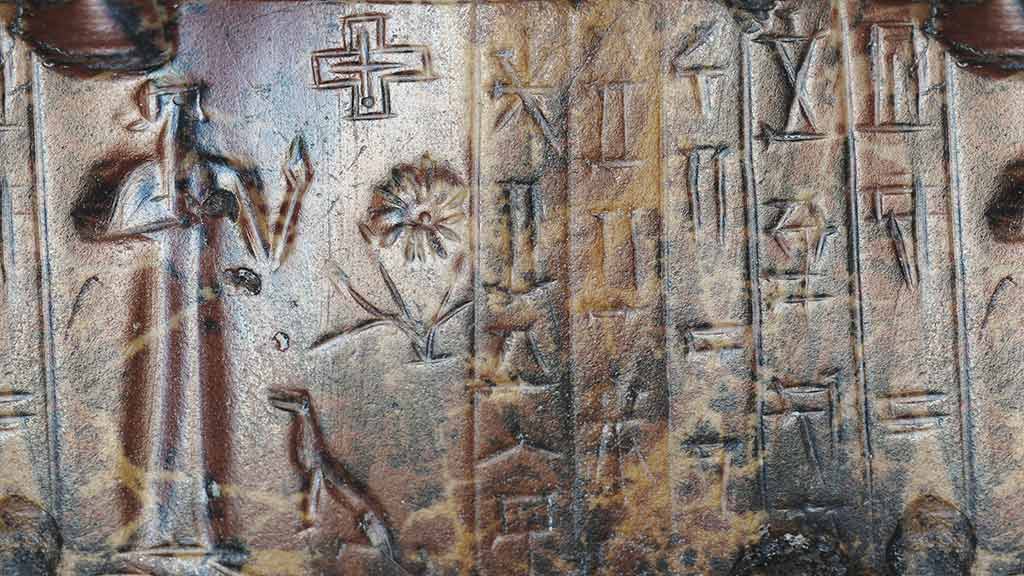 A worshiper raises his hand toward a cross. In front of him are also a dog and a flower. The inscription is a prayer to the sun god Shamash. red jasper Kassite Period (ca. 1400–1100 BCE) 1900.53.0084A
A worshiper raises his hand toward a cross. In front of him are also a dog and a flower. The inscription is a prayer to the sun god Shamash. red jasper Kassite Period (ca. 1400–1100 BCE) 1900.53.0084A -
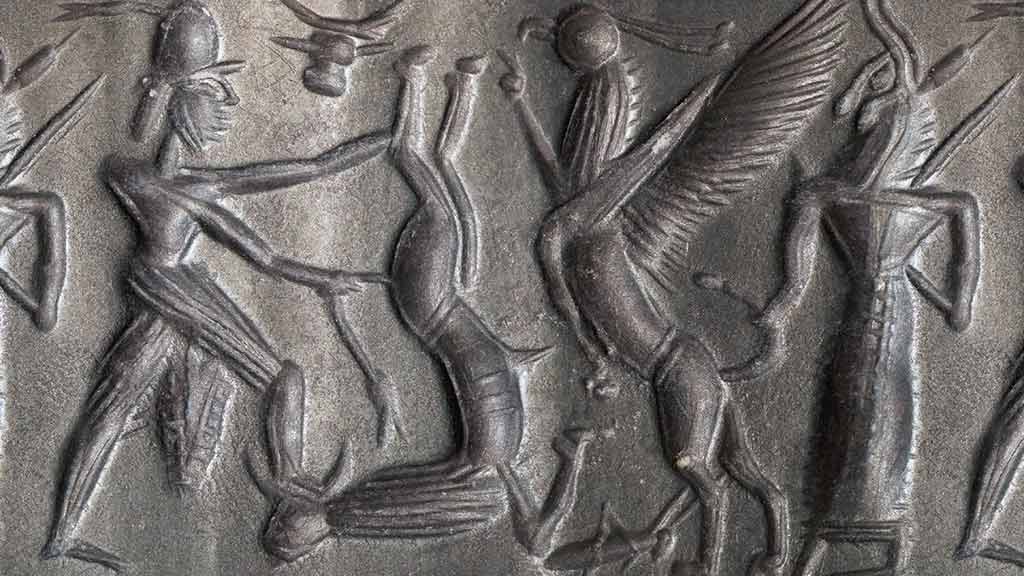 From left, a bull-headed creature, perhaps a demon, holds the tail of a griffin (part bird, part lion), while a bull is held by its hind legs by a hero. Cypriot Seal reddish hematite Late Bronze Age (ca. 1600–1050 BCE) 1900.53.0056A
From left, a bull-headed creature, perhaps a demon, holds the tail of a griffin (part bird, part lion), while a bull is held by its hind legs by a hero. Cypriot Seal reddish hematite Late Bronze Age (ca. 1600–1050 BCE) 1900.53.0056A -
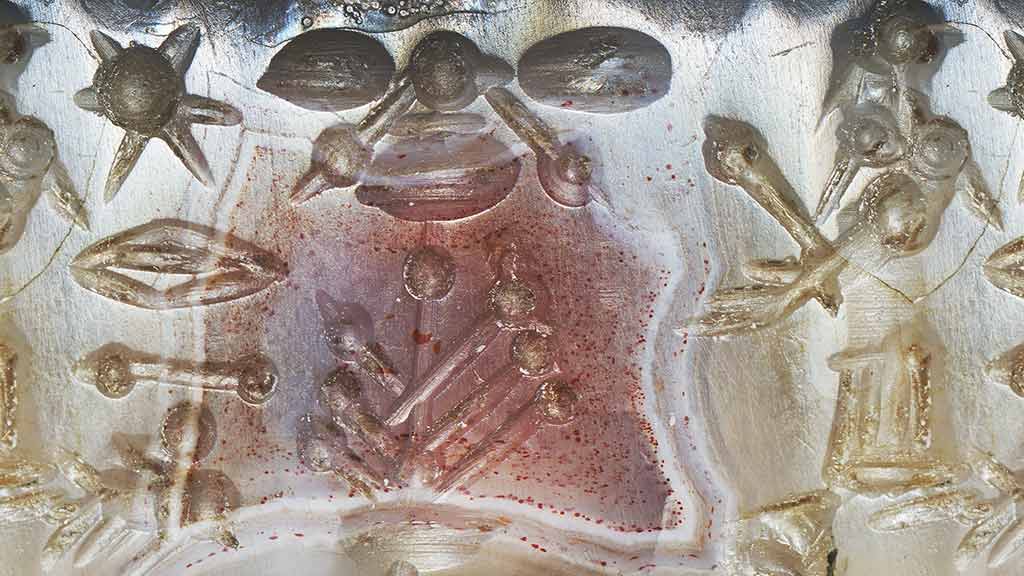 A worshiper stands before a sacred tree and a winged sun disc. agate with red hematite areas Neo-Assyrian Period (ca. 900–600 BCE) 1900.53.0097A
A worshiper stands before a sacred tree and a winged sun disc. agate with red hematite areas Neo-Assyrian Period (ca. 900–600 BCE) 1900.53.0097A -
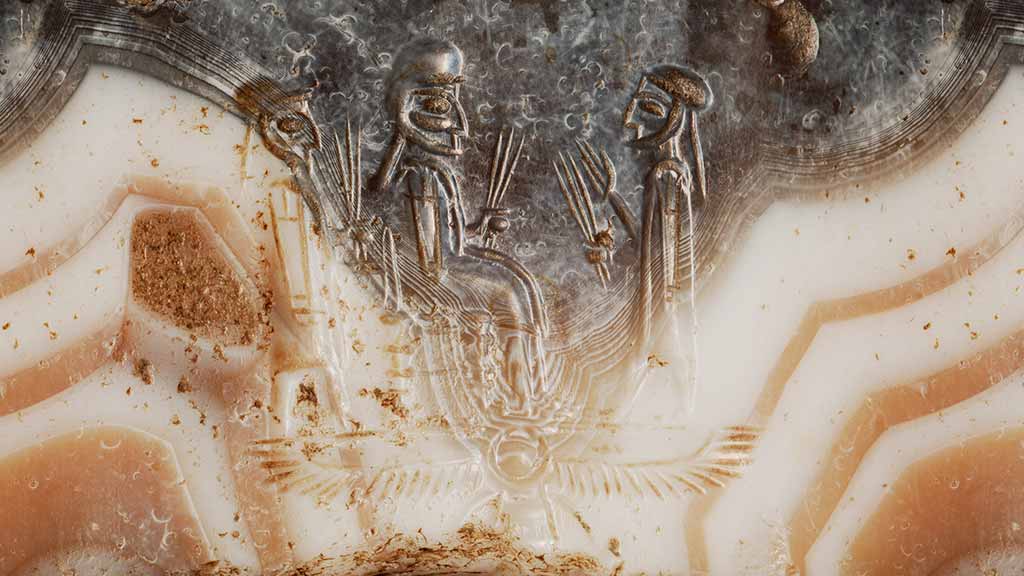 Agate with alternating bands of white and brown, below a section of gray. A seated figure, probably a magus (Zoroastrian priest), is attended by two other priests. Below the scene, and taking advantage of the white agate to portray sun-beams, is a winged sun-disc, representing Ahura-Mazda. limestone Persian Period (ca. 520–400 BCE) 1900.53.0052A
Agate with alternating bands of white and brown, below a section of gray. A seated figure, probably a magus (Zoroastrian priest), is attended by two other priests. Below the scene, and taking advantage of the white agate to portray sun-beams, is a winged sun-disc, representing Ahura-Mazda. limestone Persian Period (ca. 520–400 BCE) 1900.53.0052A -
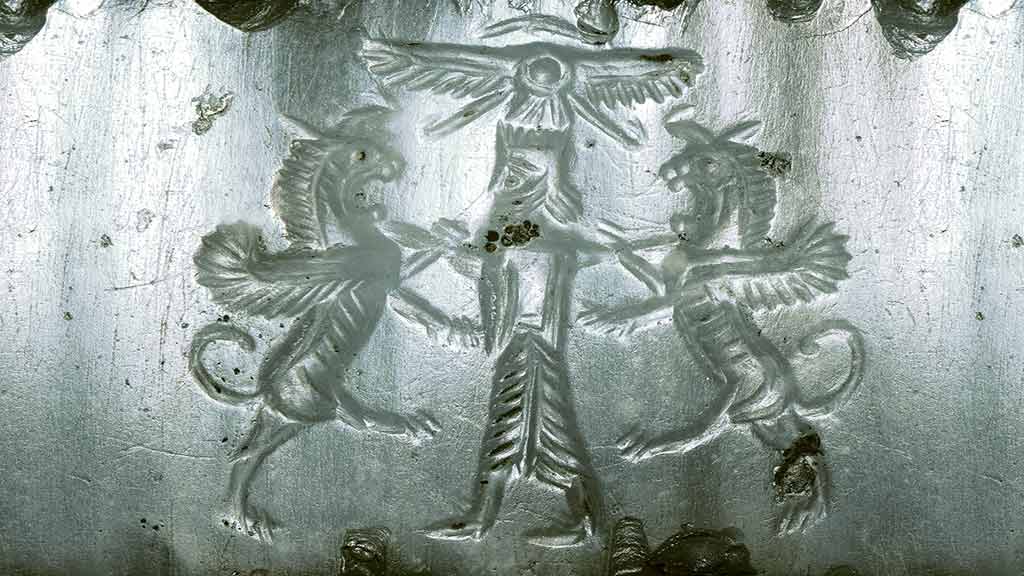 A king grasps two winged lions on either side. milky chalcedony Persian Period (ca. 520–400 BCE) 1900.53.0050A
A king grasps two winged lions on either side. milky chalcedony Persian Period (ca. 520–400 BCE) 1900.53.0050A
